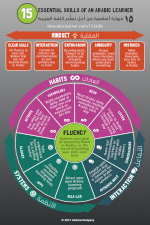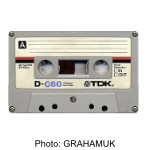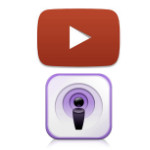 Listen to Arabic being used – spoken, sung, or recited – every day. This is foundational to building understanding, pronunciation, and a sense of the rhythm of how the language is spoken. By listening every day, you will develop an ear that can comprehend verbal Arabic effectively. This listening can be include some periods of active listening, but also longer periods of having Arabic playing in the background as you do other tasks. Daily listening builds your confidence and level of comfort when it comes to engaging in conversations in Arabic.
Listen to Arabic being used – spoken, sung, or recited – every day. This is foundational to building understanding, pronunciation, and a sense of the rhythm of how the language is spoken. By listening every day, you will develop an ear that can comprehend verbal Arabic effectively. This listening can be include some periods of active listening, but also longer periods of having Arabic playing in the background as you do other tasks. Daily listening builds your confidence and level of comfort when it comes to engaging in conversations in Arabic.
“It is very difficult to reach a high level of proficiency in speaking without being almost native in listening…the listening builds up vocabulary, and when you are listening the grammar and pronunciation become correct.” (Abbas Al-Tonsi)
This article is based on the 15 Essential Skills of an Arabic Learner.
Listen to Arabic – Resource List and Strategies

When I first began to listen to Arabic as a structured part of my learning, it involved signing out the old 7” magnetic reel audio tapes from the language lab at the American University in Cairo. Before you start thinking that I am a true dinosaur, in my defense I plead that the technology being used there was not entirely up to date for its time. It was 1991.
 Back in my student apartment, I was using more conventional cassette tapes to record Arabic news broadcasts from the radio.
Back in my student apartment, I was using more conventional cassette tapes to record Arabic news broadcasts from the radio.
 Around 2000 and 2001, I remember the excitement of realizing that I could download an increasing number of useful audio clips and movies from the internet. This was at times an excruciating exercise because we would go online with a 56K modem connection (in 2001 I did manage to upgrade to a dreamy 128K).
Around 2000 and 2001, I remember the excitement of realizing that I could download an increasing number of useful audio clips and movies from the internet. This was at times an excruciating exercise because we would go online with a 56K modem connection (in 2001 I did manage to upgrade to a dreamy 128K).
 Fast forward to 2007 or 2008, and I was able to happily listen to Arabic and view it on YouTube, and other media sites. In the past few years, I have started listening to podcasts that automatically download onto my phone and iPad.
Fast forward to 2007 or 2008, and I was able to happily listen to Arabic and view it on YouTube, and other media sites. In the past few years, I have started listening to podcasts that automatically download onto my phone and iPad.
Whether you are an old-timer or relatively new as an Arabic learner, listening plays an important role in your becoming fluent in the language. Research has shown that listening typically takes up to 40-50% of our total communication[1].
Abbas Al-Tonsi, co-author of the famous Al-Kitaab fii Tacallum al-cArabiyya – A Textbook for Beginning Arabic* and a former teacher of mine, says that listening is an essential part of achieving fluency in speaking Arabic[2]. He also says that listening plays a key role in vocabulary acquisition, grammar development, and correct pronunciation.
Because of this, establishing a daily habit of listening to Arabic is an essential skill for an Arabic learner.
Research and cognitive science show that there are ways in which you can learn to listen to Arabic more effectively. Before we go there, I will give you my list of resources for listening to Arabic. For some people reading this, that will be the main thing that they need.
Resources that can help you listen to Arabic
“Nevertheless, off-the-shelf computer and Web 2.0 technologies are now of sufficient sophistication to enable such learners to independently access and exploit listening material from within an authentic L2-mediated environment”[3] (Robin, 2007).
The list below is a curated list, as opposed to an exhaustive one. It includes sources that I have found useful, and I think will be helpful for other Arabic learners as well. In many cases, the items I have included here are lists in and of themselves.
A. Authentic materials (prepared for Arabic speakers, by Arabic speakers)
| 40 Excellent Arabic Listening Resources In All Dialects – The best and most comprehensive list of authentic listening resources for all Arabic dialects that I have found to date. The list is thorough and useful, as is typical of Donovan Nagel. Includes dialects like Egyptian, Jordanian, Syrian, Levantine, Moroccan, as well as music, children’s materials, religious, etc. I also recommend Donovan’s talkinarabic.com* paid materials, if you are looking for a big, growing library of listening material). | |
| BBC Arabic Video – BBC videos are excellent, and cover a wide range of subjects. They speak for themselves. | |
| Al-Jazeera Arabic YouTube Channel – Also excellent video covering a wide range of subjects, with a variety of levels. | |
| Yala Arabic Music YouTube Channel – Huge selection of music videos and playlists, many genres. | |
| Qur’anic recitation – There are many sites where you can listen to the Qur’an being recited (which is actually the way it was originally communicated), and this is one I find to be simple with useful controls. In terms of authentic audio materials, the Qur’an is probably the most listened to audio material in the Arab world. Religious satellite channels also can be found on YouTube, which contain many authentic sermons, discussions, etc. | |
| Biblical recitation – Also helpful if you are interested in Arab Christian authentic materials. There are many sites for audio Bible readings, this one has the entire Bible clearly laid out. Also check religious satellite channels on YouTube. | |
| Foreigncy Arabic Sets – Foreigncy has an excellent library of authentic Arabic listening materials that can be filtered by topic, difficulty level (note: it ranges from intermediate to “super-advanced”), article source (dozens of media sources), and date. These can be viewed for free (they also have other paid materials which I have not tested but look useful and high quality). |
B. Educational listening materials (prepared for Arabic learners)
| Aswaat Arabiyya (أصوات عربية) – Excellent selection of videos divided into levels (beginner, low intermediate, intermediate, advanced, highly advanced, expert), with adjustable speed control. University of Texas at Austin. | |
| Beginning Arabic Video-Based Lessons – A series of exercises that make use of Aswaat Arabiyya, developed by Dr. Mahmoud Al-Batal (co-author of the al-Kitaab series*). | |
| Arabic Webcasts in Simplified Arabic آخر الأخبار باللغة العربية المبسطة – Excellent listening exercises by the National Capital Language Resource Center. Includes simplified listening materials of various levels, and exercises. | |
| Arabic Without Walls – A free Arabic course (Modern Standard Arabic) with listening materials. Consortium for Language Learning and Teaching, uses al-Kitaab series*. | |
| LookLex Learn Arabic – Also a free Arabic course (Modern Standard Arabic) with listening materials | |
| ArabicPod101 podcast – A free podcast on iTunes, with high quality lessons and dialogues. I was impressed by this podcast, and listen to it in the car while fighting my way through Cairo traffic. (I did have a bit of a negative experience on their website, where I thought I was making a one time payment of $1 to get trial access their full materials, and then found a $25 recurring charge on my credit card the following month that I was not aware was coming. To their credit, their customer service was very responsive and refunded the charge immediately. I probably missed the fine print somewhere, so just be sure to read the text carefully.) | |
| ArabicPod podcast – A free podcast on iTunes that contains various lessons with dialogues. Sometimes you have to get through a bit of English chit-chat by the instructors, but overall it’s a useful resource. |
The science of listening
Listening as we learn a language is a complex process, but research has helped us to understand it better. Being aware of what happens when we listen can help us choose approaches that bring success in listening comprehension.
In the following section, I will attempt to summarize some of the most important points about the listening process, based on a brief summary article by Larry Vandergrift, a well-known language teacher and researcher[4]. My goal is to give a brief and actionable (not academic) overview of this very big subject. I encourage anyone interested in this to use the Vandergrift article and its bibliography, or any of the other links below, as a launching point for further study.
Selective listening, based on the purpose
Listeners do not listen to everything. They are selective in what they take in, depending on the purpose of their listening. There are two main types of listening:
- Interactional – this is socially oriented communication that involves interaction in two directions between two or more speakers.
- Transactional – this is communication in which a message or content is delivered. It is usually one-way, such as a lecture or a news broadcast.
Knowing the communicative purpose of what you are listening to will help you determine what to listen for. This in turn will help you to know what skills and strategies to use.
 Interactional listening allows opportunities for clarification from the speaker (which can help in comprehension), but also require paying attention to cues and expressions that are a part of that back and forth interaction. The listener does not need to take in every word of what is being said, because there is opportunity to clarify.
Interactional listening allows opportunities for clarification from the speaker (which can help in comprehension), but also require paying attention to cues and expressions that are a part of that back and forth interaction. The listener does not need to take in every word of what is being said, because there is opportunity to clarify.
Transactional listening requires accurate understanding of what is being said with no opportunity for clarification from the speaker. This puts an increased emphasis on the need to understand the meaning of each word and expression the first time around.
When I am listening to an interactive discourse, I find it helpful to focus on understanding the main thing that is being said, and seek feedback and clarification from the speaker. Taking advantage of the interaction means not being afraid of communicating that I did not understand something, or only partially understood it (something that many of us find difficult, because we have an irrational compulsion to be seen as knowing everything).
When I am listening to a transactional discourse, I find it particularly helpful to focus on key words and their meaning, and to think through the context of what is being spoken in advance. Of course, key words and context can also help in interactive listening, but for me they are even more important in transactional listening.
Intensive and extensive listening
Just like reading Arabic (see my previous blog post on this), you can listen to Arabic either intensively or extensively. Usually a combination of the two is most helpful.
- Intensive listening is usually understood to mean taking shorter passages and listening to them thoroughly, carefully working to understand vocabulary, structure, and meaning.
- Extensive listening can refer to all types of listening activities that allow learners to receive a high amount of comprehensible (and hopefully enjoyable) listening input[5].
Most language teaching programs (whether classroom, online, software based, etc.) tend to focus on intensive listening. This is often due to time constraints. You can only spend so much time with the teacher, and therefore shorter exercises fit more easily into the schedule. Intensive listening often tends to be more active, which fits well with classroom models. To some extent, recent improvements in software and web-based apps are allowing intensive listening to be taken out of the classroom (many of my sources in my list above are useful for intensive listening).
However, there is also an important place for extensive listening. This can include listening to Arabic “passively” while doing other activities (my favorites are driving and preparing meals). Research suggests that some of the benefits of extensive listening can include:
- enhancing your ability to deal with normal speech rates
- improving word recognition skill
- enabling you to hear word boundaries more clearly
- increasing the rate at which you automatically process what you hear
How our brains listen
According to Vandergrift and other researchers, there are two different ways that our brains engage in listening comprehension:
- Top-Down – this is when we use prior knowledge of what is being talked about to understand the message. This prior knowledge is referred to as schema, and refers to things stored in our long-term memory such as knowledge of the context, cultural understanding, general background, previous interactions, etc. In a top-down approach, your brain listens for key words and phrases that activate this schema. It then tries to assemble a hypothesis of the meaning by exploring all of the resources it comes up with.
- Bottom-Up – this is when your brain uses a linguistic approach to understanding what it is hearing. It trains its energy on discriminating sounds and phonemes (units of sound), building words and grammatical structures out of them, interpreting stress and intonation, and so on.
Ultimately, our brains use a combination of these two approaches to comprehend what we are hearing. The bottom-up approach is gathering and compiling linguistic data, while the top-down approach is interpreting the data within the context.
Strategies for listening to Arabic
Based on this understanding of how the brain listens, we can form some strategies that may optimize our comprehension when we listen to Arabic.
 One important factor when you listen to Arabic is the idea of comprehensible input[6]. According to research (such as this, and others) we grow in language proficiency when we understand what we hear and read. In other words, the materials that we are listening to must be comprehensible to us. This doesn’t mean that we need to understand 100% of what is being said (otherwise there would be no stretching to learn). But that we need to be able to follow enough of what is being communicated that we can fully activate top-down and bottom-up strategies.
One important factor when you listen to Arabic is the idea of comprehensible input[6]. According to research (such as this, and others) we grow in language proficiency when we understand what we hear and read. In other words, the materials that we are listening to must be comprehensible to us. This doesn’t mean that we need to understand 100% of what is being said (otherwise there would be no stretching to learn). But that we need to be able to follow enough of what is being communicated that we can fully activate top-down and bottom-up strategies.
One study gives three types of strategy[7] that may be helpful to you:
Meta-cognitive
This type of strategy involves determining how you will approach your listening. It is not a strategy that you do while listening, but before it. It includes setting objectives, making a plan, determining in advance how you will check comprehension, and planning revision and evaluation.
Examples:
- Write down your goals for listening. What do you want to be able to accomplish?
- Write down a plan for how often you will listen to Arabic, and what types of materials you will listen to.
- Compile a list of things you will listen to in the coming month, based on your own interests, and your need for comprehensible input (input that you understand enough to be valuable)
- Think through how you will check your comprehension, and evaluate what you have learned. Reflection? Quizzes? A friend? Other?
- Cognitive
Do activities before, during, and after listening that will help your brain process and understand the input it has just received. Use both a top-down and a bottom-up approach.
Examples:
- Pre-listening: review key vocabulary, think through what you know about the listening topic (brainstorm, mind-map, free-write)
- While listening: note key words, write an outline, seek clarification (if it is transactional listening)
- Post-listening: answer questions, summarize, respond. Here’s a set of creative ways that you can check comprehension, as given by Alex Own-Hill in his helpful article:
- Try drawing a picture of what was said.
- Ask yourself some questions about it and try to answer them.
- Provide a summary of what was said.
- Suggest what might come next in the “story.”
- Translate what was said into another language.
- “Talk back” to the speaker to engage in imaginary or real conversation
Social/Affective
This kind of strategy involves setting up your environment in a way that is most conducive socially and emotionally (reducing anxiety) to your learning style
Examples:
- Listen to something with a friend (also learning Arabic) and pause the listening material at set intervals to compare/discuss what you have heard so far.
- Mute your phone and use noise-blocking headphones to remove distractions as you listen.
- Ask the person speaking to you if they can go a bit slower than normal, because you are still learning Arabic. This will decrease stress.
- Use a setup on your computer where you can easily pause what you are listening to, reducing the stress of potentially falling behind.
Get listening!
I hope that this blog post motivates and equips you to engage in the daily habit of listening to Arabic. Whether your main need is to find useful listening materials, or to understand how to form an effective learning strategy for listening, or just to understand how the process works, there should be something here for you that you can put into action.
What have you found helpful when you want to listen to Arabic? What resources have been useful for you? I’d love to hear back from you.
*This link is an affiliate link, which means that for each purchase of a product that is made by someone who follows this link, a small amount of money (anything from several cents to several dollars) from the purchase is given by the owner of the product or service toward the upkeep and maintenance of this blog. This comes at no extra charge to the purchaser. It does not in any way influence which products I recommend. You will find that most of the links I recommend are either free or not affiliate links. I only recommend products that I have either used personally, or have received first hand feedback from people I trust. Always use your own good judgment in deciding whether a product or service is useful for you in your Arabic learning journey. Feel free to send me any recommendations you may have.
[1] Mendelsohn, D.J. (1994). Learning to Listen: A strategy-based approach for the second-language learner. San Diego, CA: Dominic Press. p. 9.
[2] Personal interview with Abbas Al-Tonsi, May 1, 2015
[3] Robin, R. (2007). Learner-based listening and technological authenticity. Language Learning &
Technology, 11, 109–115.
[4] Vandergrift, Larry. ” Listening: theory and practice in modern foreign language competence”. Center for Languages, Linguistics, and Area Studies, University of Southampton. Accessed 4 April, 2016.
[5] Renandya, W. (2012). “Materials and methods for extensive listening (plenary paper presentation)”. 59th TEFLIN International Conference, Surabeya.
[6] Krashen, S. (2003). Explorations in Language Acquisition and Use: The Taipei Lectures. Portsmouth, NH: Henemenn.
[7] Gilakjani, Abbas, & Mohammad Reza Ahmadi. “A Study of Factors Affecting EFL Learners’ English Listening Comprehension and the Strategies for Improvement.” Journal of Language Teaching and Research [Online], 2.5 (2011): 977-988. Web. 5 Apr. 2016



 RSS - Posts
RSS - Posts